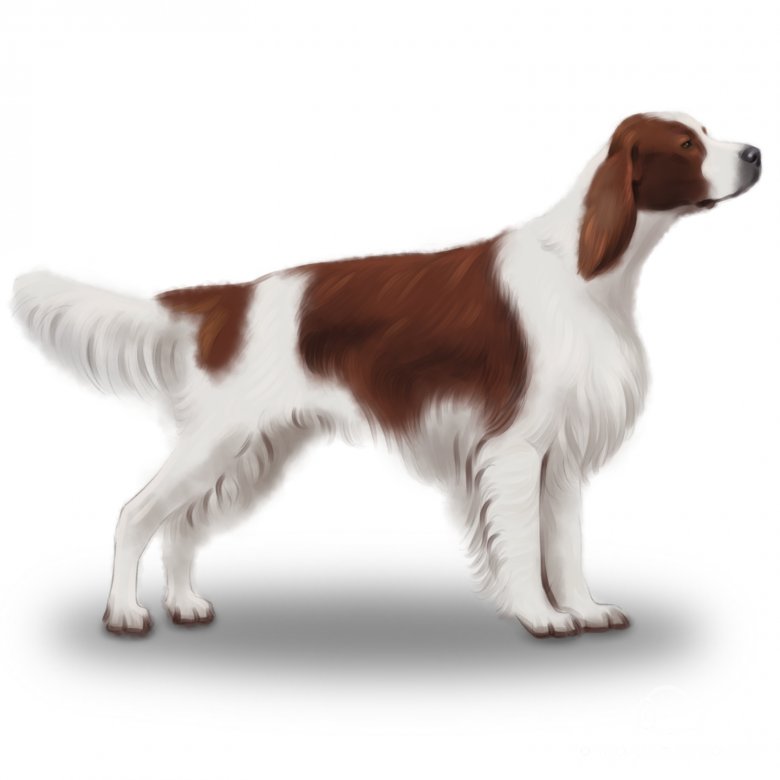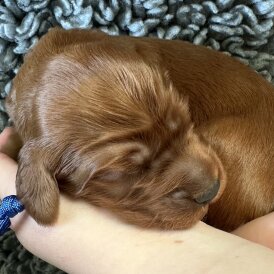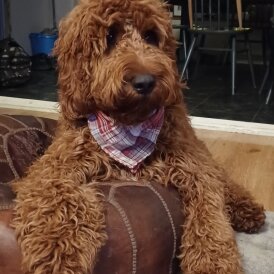Many Irish dog breeds have an excellent mix of beautiful aesthetics and a kind, gentle temperament. The Irish Setter certainly doesn’t disappoint in these regards. This large gundog, formerly called the Red Setter, is an ideal puppy choice for those looking for loyal lifelong companions that exude glamour and elegance. As one of the oldest setter breeds, Irish Setters maintain their purity as well as many superb characteristics that contribute to making them amongst the most popular setter breeds. As puppies, Irish Setters can put a smile on just about anyone’s face as easily as they can turn heads for their sociable nature and uniquely good-looking coat of fur.
Why Irish Setters are Great
Some highlights of Irish Setters:
First-time owners: this breed is an ideal puppy choice for first-time owners.
Sociable: Irish Setters are sociable and enjoy spending time with owners and their families.
Child-friendly: Irish Setters are a great choice for families with children since they love to play.
Shedding: this breed doesn’t shed much, making cleaning easier.
Companionship: affectionate and loyal are amongst this breed’s defining characteristics.
Things to Consider when Looking at Irish Setters for Sale
Some downsides to the Irish Setter:
Grooming: Irish Setters have feathered coats that require frequent grooming.
Behaviour: Although often well-behaved, Irish Setters may be naughty and can engage in boisterous or destructive behaviour if improperly trained.
Exercise: this breed requires frequent exercise to remain happy.
Loneliness: Irish Setters don’t handle isolation very well and are best considered if owners and family members can keep them company.
History of the Irish Setter
Three setter breeds from Ireland once existed: Red Setters, Red and White Setters, and Hail Setters. What is now referred to as the Irish Setter (and sometimes still the Irish Red Setter) became the favoured breed. The Hail setter is believed to be extinct. The Red and White Setter lost much of its popularity to the Irish Setter by the end of the 19th century. The earliest predecessors of the modern Irish Setter can be traced back to the 16th-century work De Canibus Britannicus by Caius. Although their description differs from that of modern Irish Setters, their purpose as hunting dogs and scenting dogs was an accurate description of the modern breed’s original purpose. What is today recognisable as a terrier breed began to take shape by the 18th century when Irish gentry began breeding programmes and documenting breeds more thoroughly than in the past. It was not until 1886 that the Irish Setter became a standard breed recognised by the Irish Red Setter Club in Dublin.
Appearance
Irish Setters are glamorous and elegant in their posture and kindly in their disposition. Their racy, athletic physique hides the fact that they are, historically, working dogs that enjoy an active lifestyle. The most distinctive feature of Irish Setters is their silky rich red-coloured coat that’s adaptable to colder climates.
How big is the Irish Setter?
Irish Setters are large-sized dogs. Males grow on average to 58-67 cm in height, whilst females can grow up to 54-62 cm high.
How heavy is an Irish Setter?
Fully-grown adult male Irish Setters weigh between 27-32 kg on average, whilst females weigh between 24-29 kg.
What colour is the Irish Setter?
Irish Setters are, as their former name implies, red in colour. More specifically, a rich chestnut colour is preferable, while patches of white may be also common on the chest, throat, and their toes.
Temperament
As a word of caution, Irish Setters have a temperament that can be as fiery as their rich red coats of fur. This breed was originally bred for hunting and as a working dog, but many of their old instinctive habits remain even in domestic settings where hunting and working aren’t necessary duties. As puppies, Irish Setters can be quite naughty and they may engage in destructive behaviour if left unsupervised. Furthermore, this type of boisterous behaviour may be hazardous around infants and young children. As a counterbalance to their downsides, however, Irish Setters can be one of the best puppy choices for families and first-time owners alike. They form loving bonds that last well into adulthood and are always eager to socialise and explore people and places around them.
Do Irish Setters make good guard dogs?
Irish Setters are not very good guard dogs since they are rarely, if ever, aggressive. They do not make good watchdogs, either.
Do Irish Setters bark a lot?
This breed tends to bark more than average and may engage in excessive barking, especially as puppies whenever they’re excited or alerted.
Are Irish Setters easy to train?
Irish Setters can be easy to train, but they can also be mischievous at times which means that training will certainly require patience and persistence.
Are Irish Setters playful?
Young Irish Setter puppies love to play, but agility is not their most pronounced skill and as such, they may knock over furniture or plants in the home when overly excited. Teach them their boundaries as puppies and they will gradually understand what constitutes ‘good’ play and ‘bad’ play.
Are Irish Setters good with children?
This breed gets along well with children, but especially older children. Young children should be supervised at all times, however, since Irish Setters can easily knock over objects or inadvertently harm the child.
Are Irish Setters good with other pets?
Generally, Irish Setters get along well with other pets. They tend to get along with other dogs but may require ample socialisation before getting along with cats or smaller pets. Introduce pets gradually and maintain supervision. Irish Setters are sensitive pets and can learn to get along with pets if given the chance.
Can I leave an Irish Setter alone?
Although Irish Setters can be taught to tolerate loneliness, they may not bear it well at first. As puppies, teach them that going to work and leaving for a few hours isn’t something to be afraid of and reward them for proper behaviour upon returning home.
Do Irish Setters like water?
Provided that an Irish Setter puppy learns to enjoy the water without being frightened, they can make superb swimmers. Every puppy has its own feelings about water, however, with some preferring to never swim at all whilst others will jump in any chance they get. They’re also fond of being on boats.
Health
How long do Irish Setters live?
Generally, Irish Setters are expected to live anywhere from 10-15 years.
How much exercise does an Irish Setter need?
This breed requires a high amount of exercise. At least two hours per day should be spent walking, playing, and exercising with Irish Setters. Younger puppies shouldn’t be overexercised, so endeavour to get them accustomed to playing outdoors without straining their growing bodies.
What are Irish Setters’ common health issues?
Irish Setters are a generally healthy breed with few hereditary issues. Some common health issues to look out for are:
As puppies, many Irish Setters may develop gluten intolerance or Coeliac disease.
Care
How much space do I need for an Irish Setter?
This large breed doesn’t handle apartments or small, confined homes very much. It’s best to provide Irish Setters with a large home, preferably with a large garden and lawn where they can roam and maintain healthy exercise.
What should I feed my Irish Setter?
Irish Setters need 3 to 4 cups of high-quality dog food every day, divided into two meals. Puppies can be fed a little less and should have their diets adjusted according to their activity levels and to avoid overfeeding.
How much grooming do Irish Setters need?
As with many large breeds with long fur and feathered coats, Irish Setters require frequent grooming. They are high-maintenance and need to be brushed often to remove knots and objects such as brambles and dead hair from their silky coats.
Do Irish Setters shed?
This breed doesn’t shed profusely, but some normal shedding is to be expected. Compared to many other breeds of a similar size, however, Irish Setters shed little.
Average Costs
How much does it cost to keep an Irish Setter?
As a rough guide in pricing: Cost to buy: roughly £500-600 for a well-bred Irish Setter puppy Other costs (Vet, Food etc): £80-110 per month
Specific Buying Guide
You can read our general buying guide here, with the most important thing being going to view your Irish Setter puppy, seeing it with its mother, and checking the quality of the breeder. More specifically, here is some Irish Setter puppy buying advice:
Don’t purchase an Irish Setter if you haven’t got the patience and persistence required to overcome its mischievous side. This breed can become a loving companion with proper training, but they can equally become troublesome and destructive if neglected and uncared for.
Irish Setters aren’t rare, but they are quite a popular choice in the UK at the moment. This makes them susceptible to being bred in unethical conditions by ‘puppy mills’ and sellers looking to scam prospective buyers. If a deal sounds too good to be true, it probably is. Don’t hesitate to spend a little more buying from a reputable seller of Irish Setters.
Other Reading, Adopting Irish Setter Puppies and Rescue Organisations
A big thank you to the following sources who helped to shape this article: Kennel Club of Great Britain: https://www.thekennelclub.org.uk/services/public/breed/display.aspx?id=2039 Federation Cynologique Internationale: https://www.fci.be/Nomenclature/Standards/120g07-en.pdf Dogell: https://dogell.com/en/dog-breed/irish-setter https://www.irishsetterrescue.org.uk/ https://www.israndr.com/













